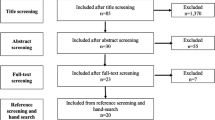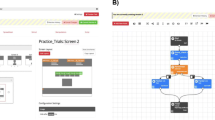Abstract
The MORE system is designed for observation and machine-aided analysis of social interaction in real life situations, such as classroom teaching scenarios and business meetings. The system utilizes a multichannel approach to collect data whereby multiple streams of data in a number of different modalities are obtained from each situation. Typically the system collects a 360-degree video and audio feed from multiple microphones set up in the space. The system includes an advanced server backend component that is capable of performing video processing, feature extraction and archiving operations on behalf of the user. The feature extraction services form a key part of the system and rely on advanced signal analysis techniques, such as speech processing, motion activity detection and facial expression recognition in order to speed up the analysis of large data sets. The provided web interface weaves the multiple streams of information together, utilizes the extracted features as metadata on the audio and video data and lets the user dive into analyzing the recorded events. The objective of the system is to facilitate easy navigation of multimodal data and enable the analysis of the recorded situations for the purposes of, for example, behavioral studies, teacher training and business development. A further unique feature of the system is its low setup overhead and high portability as the lightest MORE setup only requires a laptop computer and the selected set of sensors on site.










Similar content being viewed by others
References
Amidon E, Flanders N (1967) The role of the teacher in the classroom, (revised edition). Association for Productive Teaching Inc
Anderson H (1939) The measurement of domination and of socially integrative behavior in teachers’ contacts with children. Child Dev 10:73–89
Anderson H, Brewer H (1945) Studies of teachers’ classroom personalities, I. Dominative and socially integrative behavior of kindergarten teachers. Stanford University Press, Stanford, Cal
Anderson H, Brewer J (1946) Studies of teachers’ class-room personalities, II. Effects of dominative and integrative contacts on children’s classroom behavior. Stanford University Press, Stanford, Cal
Chang CC, Lin CJ (2011) LIBSVM: a library for support vector machines. ACM Trans Intell Syst Technol 2(3):27. doi:10.1145/1961189.1961199. software available at. http://www.csie.ntu.edu.tw/cjlin/libsvm
Derry S, Pea R, Engle R, Erickson F, Gpödman R, Hall R, Koschmann T, Lemle J, Sherin M, Sherin B (2010) Conducting video research in the learning sciences: Guidance on selection, analysis, technology, and etchics. J Learn Sci 19(1):3–53
eXist Solutions GmbH (2000) exist-db: Open source native XML database. Online, http://exist-db.org/, accessed April 25, 2014
Flanders N (1970) Analysing Teaching Behavior. Addison-Wesley Pub. Co. Reading, Mass
Gatica-Perez D (2009) Automatic nonverbal analysis of social interaction in small groups: A review. Image Vis Comput (Vis multimodal anal hum spontaneous behav) 27(12):1775–1787. doi:10.1016/j.imavis.2009.01.004
Goldman R (2007) Orion™, an online digital video analysis tool: Changing our perspectives as an interpretive community, Lawrence Erlbaum Associates, Mahwah, NJ, pp 507–520
Horn BK, Schunck BG (1981) Determining optical flow. Artif Intell 17(1):185–203
Horn E (1914) Distribution of opportunity for participation among the various pupils in classroom recitations. Contributions to Education, 67
International Telecommunication Union (ITU) (2012) P.56: Objective measurement of active speech level. Online, http://www.itu.int/rec/T-REC-P.56, accessed August 18, 2014
IRIS Connect (2012) Classroom observation — lesson observation — teacher professional development. Online, http://www.irisconnect.co.uk/, accessed August 18, 2014
Kiema H, Mäenpää M, Leinonen T, Soini H (2014) Peer group counseling as a tool for promoting managers’ communication skills in industrial and planning organizations. In: COLLA 2014, The Fourth International Conference on Advanced Collaborative Networks, Systems and Applications, pp 28–33, http://www.researchgate.net/publication/263203534_Peer_Group_Counseling_as_a_Tool_for_Promoting_Managers%27_Communication_Skills_in_Industrial_and_Planning_Organizations
Mchenry V (1968) The use of video processes in teacher education. Multi-State Teacher Education Project, Baltimore, MD. & Utah State Board of Education, Salt Lake City. D.C, Washington
Noldus (1989) Software and labs for behavioral research and video tracking., http://www.noldus.com/, accessed April 25, 2014
OpenCV (1999) Open source computer vision library. Online., http://code.opencv.org/, accessed December 10, 2014
Pea R, Lindgren R (2008) Video collaboratories for research and education: An analysis of collaboration design patterns. IEEE Trans Learn Technol 1(4):235–247. doi:10.1109/TLT.2009.5
Pea R, Mills M, Rosen J, Dauber K, Effelsberg W, Hoffert E (2004) The Diver project: Interactive digital video repurposing. IEEE Multimedia:54–61. doi:10.1109/MMUL.2004.1261108
Point Grey Research Inc (2013) Accurate 360° spherical imaging with multiple pre-calibrated sensors. Online., http://www.ptgrey.com/Content/Images/uploaded/misc/Ladybug-Spherical-Cameras-WhitePaper.pdf, accessed February 24, 2015
Powell AB, Francisco JM, Maher CA (2003) An analytical model for studying the development of learners’ mathematical ideas and reasoning using videotape data. J Math Behav 22(4):405–435. doi:10.1016/j.jmathb.2003.09.002
Puckett RC (1928) Making supervision objective. School Rev 36:209–212
Schreer O, Fieldmann I, Weissig C, Kauff P, Schafer R (2013) Ultrahigh-resolution panoramic imaging for format-agnostic video production. Proc IEEE 101(1):99–114
Siipo A, Laukka S, Seppänen T, Toivanen J, Partala J, Väyrynen E, Lehtihalmes M, Mattila P, Miettunen, J, Heikkilä J (2010) The multi-technological analyses of learning in the future classroom: Preliminary observatory apparatus. In: Martens A, Tavangarian D, Urban B, Hambach S (eds) 3rd International eLBa Science Conference. Fraunhofer Verlag, pp 60–66
Soleymani M, Lichtenauer J, Pun T, Pantic M (2012) A multimodal database for affect recognition and implicit tagging. IEEE Trans Affect Comput 3(1):42–55
Stevens R, Cherry G, Fournier J (2002) Video traces: Rich media annotations for teaching and learning. In: Proc. Conference on Computer Supported Collaborative Learning
Sun X, Foote J, Kimber D, Manjunath B (2001) Panoramic video capturing and compressed domain virtual camera control. In: Proc. ACM Int. Conf. Multimedia, pp 329–347. doi:10.1145/500141.500191
Sun X, Foote J, Kimber D (2005) Region of interest extraction and virtual camera control based on panoramic video capturing. IEEE Trans Multimedia 7:981–990
Teachscape (1999) Teachscape homepage. Online., http://www.teachscape.com/, accessed April 25, 2014
Transana (2005) Qualitative analysis of software for video and audio data. Online, http://www.transana.org, accessed January 12, 2014
Väyrynen E, Keränen H, Seppänen T, Toivanen J (2005) Performance of f0tool: A new speech analysis software for analyzing large speech data sets. In: Proc 2nd Baltic Conference on Human Language Technologies, Tallinn, Estonia
Väyrynen E, Kortelainen J, Seppänen T (2013) Classifier-based learning of nonlinear feature manifold for visualization of emotional speech prosody. IEEE Trans Affect Comput 4:47–56. doi:10.1109/T-AFFC.2012.35
Viola P, Jones M (2004) Robust real-time face detection. Int J Comput Vis 57(2):137–154. doi:10.1023/B:VISI.0000013087.49260.fb
Wong WK, Poh YC, Loo CK, Lim WS (2010) Wireless webcam based omnidirectional health care surveillance system. In: Second Int. Conf. Computer Research and Development, Second Int. Conf. Computer Research and Development. doi:10.1109/ICCRD.2010.178
Zhao G, Pietikäinen M (2007) Dynamic texture recognition using local binary patterns with an application to facial expressions. IEEE Trans Pattern Anal Mach Intell 29(6):915–928. doi:10.1109/TPAMI.2007.1110
Author information
Authors and Affiliations
Corresponding author
Rights and permissions
About this article
Cite this article
Keskinarkaus, A., Huttunen, S., Siipo, A. et al. MORE – a multimodal observation and analysis system for social interaction research. Multimed Tools Appl 75, 6321–6345 (2016). https://doi.org/10.1007/s11042-015-2574-9
Received:
Revised:
Accepted:
Published:
Issue Date:
DOI: https://doi.org/10.1007/s11042-015-2574-9




